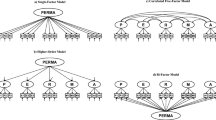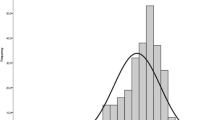Abstract
The aim of this work is to offer an exam of the PERMA-Profiler’s psychometric proprieties in an Italian context, with particular attention to convergent validity measured through one of the most used instruments for assessing psychological well-being, the Ryff’s Psychological Well-Being Scale (Ryff in Journal of Personality and Social Psychology, 57(6), 1069, 1989, Psychotherapy and Psychosomatics, 83(1), 10–28, 2014; Italian version by Ruini et al. in Rivista di psichiatria, 38(3), 117–130, 2003). Italian version of PERMA-Profiler appears to have good psychometric qualities, and its factorial structure is consistent with the original one (Butler & Kern in International Journal of Wellbeing, 6(3), 1–48, 2016), in line with Seligman’s PERMA model (Seligman 2011). Although the dimension of Ryff’s Autonomy subscale shows low correlation indices with PERMA subscales, the two Overall dimensions (Overall PERMA and Ryff’s Psychological Well-Being total) show a good relation (r = .81). This data tends to favor the idea that the PERMA-Profiler is an instrument capable of measuring well-being, in a certainly more streamlined way (23-items vs 84-items), from a eudaimonic point of view (Ryff in Psychotherapy and Psychosomatics, 83(1), 10-28, 2014), and, with its attention to aspects related to positive emotions and happiness (factors Positive emotions and Engagement, and Happiness single-item) the instrument appears to be trans-theoretical, by also offering a hedonic and subjective vision of well-being.

Similar content being viewed by others
References
Biswas-Diener, R., Kashdan, T. B., & King, L. A. (2009). Two traditions of happiness research, not two distinct type of happiness. The Journal of Positive Psychology, 4(3), 208–211.
Butler, J., & Kern, M. L. (2016). The PERMA-Profiler: A brief multidimensional measure of flourishing. International Journal of Wellbeing, 6(3), 1–48.
Cangur, S., & Ercan, I. (2015). Comparison of model fit indices used in structural equation modeling under multivariate normality. Journal of Modern Applied Statistical Methods, 14(1), 14.
César Cosentino, A., & Castro Solano, A. (2014). The assessment of multicultural strength: Design and validation of an openness to the other affective domain inventory. European Journal of Psychological Assessment, 30(4), 261–273.
Crawford, J. R., & Henry, J. D. (2004). The positive and negative affect schedule (PANAS): Construct validity, measurement properties and normative data in a large non-clinical sample. British Journal of Clinical Psychology, 43, 245–265.
Csikszentmihalyi, M. (1990). Flow: The psychology of optimal experience. New York: Harper & Row.
Diener, E. (1984). Subjective well-being. Psychological Bulletin, 95(3), 542.
Diener, E. D., Emmons, R. A., Larsen, R. J., & Griffin, S. (1985). The satisfaction with life scale. Journal of Personality Assessment, 49(1), 71–75.
Diener, E., Sapyta, J. J., & Suh, E. (1998). Subjective well-being is essential to well-being. Psychological Inquiry, 9(1), 33–37.
Diener, E., Suh, E. M., Lucas, R. E., & Smith, H. L. (1999). Subjective well-being: Three decades of progress. Psychological Bulletin, 125(2), 276.
Diener, E., Wirtz, D., Biswas-Diener, R., Tov, W., Kim-Prieto, C., Choi, D. W., & Oishi, S. (2009). New measures of well-being. In Assessing well-being (pp. 247–266).
Diener, E., Wirtz, D., Tov, W., Kim-Prieto, C., Choi, D. W., Oishi, S., & Biswas-Diener, R. (2010). New well-being measures: Short scales to assess flourishing and positive and negative feelings. Social Indicators Research, 97(2), 143–156.
Eaton, W. W., Smith, C., Ybarra, M., Muntaner, C., & Tien, A. (2004). Center for Epidemiologic Studies Depression Scale: review and revision (CESD and CESD-R).
Fordyce, M. W. (1988). A review of research on the happiness measures: A sixty second index of happiness and mental health. Social Indicators Research, 20, 63–89.
Fordyce, M. W. (2000). Human happiness its nature & its attainment. Available online: https://happyecho.com/human-happiness-its-nature-and-its-attainment-table-of-contents/
Gershon, R. C., Cella, D., Fox, N. A., Havlik, R. J., Hendrie, H. C., & Wagster, M. V. (2010). Assessment of neurological and behavioural function: The NIH toolbox. The Lancet Neurology, 9(2), 138–139.
Henderson, L. W., & Knight, T. (2012). Integrating the hedonic and eudaimonic perspectives to more comprehensively understand wellbeing and pathways to wellbeing. International Journal of Wellbeing, 2(3), 196–221.
Hone, L. C., Jarden, A., Schofield, G. M., & Duncan, S. (2014). Measuring flourishing: The impact of operational definitions on the prevalence of high levels of wellbeing. International Journal of Wellbeing, 4(1), 62–90.
Huppert, F. A. (2009). Psychological well-being: Evidence regarding its causes and consequences. Applied Psychology. Health and Well-Being, 1(2), 137–164.
Huppert, F. A., Marks, N., Clark, A., Siegrist, J., Stutzer, A., Vittersø, J., & Wahrendorf, M. (2009). Measuring well-being across Europe: Description of the ESS well-being module and preliminary findings. Social Indicators Research, 91(3), 301–315.
Huppert, F. A. (2014). The state of wellbeing science. Wellbeing: John Wiley & Sons.
Huppert, F. A., & Cooper, C. L. (Eds.). (2014). Wellbeing: A Complete Reference Guide, Interventions and Policies to Enhance Wellbeing (Vol. 6). John Wiley & Sons.
Huppert, F. A., Abbott, R. A., Ploubidis, G. B., Richards, M., & Kuh, D. (2010). Parental practices predict psychological well-being in midlife: Life-course associations among women in the 1946 British birth cohort. Psychological Medicine, 40(9), 1507–1518.
Iacobucci, D. (2010). Structural equations modeling: Fit indices, sample size, and advanced topics. Journal of Consumer Psychology, 20(1), 90–98.
Kahneman, D., & Krueger, A. B. (2006). Developments in the measurement of subjective well-being. The Journal of Economic Perspectives, 20(1), 3–24.
Kashdan, T. B., Biswas-Diener, R., & King, L. A. (2008). Reconsidering happiness: The costs of distinguishing between hedonics and eudaimonia. The Journal of Positive Psychology, 3, 219–233.
Kern, M. L., & Butler, J. (2013). The PERMA-Profiler: A brief multidimensional measure of flourishing. In Poster presented at the Third World Congress on Positive Psychology, Los Angeles.
Keyes, C. L. M. (1998). Social well-being. Social Psychology Quarterly, 61(2), 121–140.
Keyes, C. L. (2002). The mental health continuum: from languishing to flourishing in life. Journal of Health and Social Behavior, 43(2), 207–222.
Keyes, C. L. (2005). Mental illness and/or mental health? Investigating axioms of the complete state model of health. Journal of Consulting and Clinical Psychology, 73(3), 539.
Keyes, C. L. (2007). Promoting and protecting mental health as flourishing: A complementary strategy for improving national mental health. American Psychologist, 62(2), 95.
Layard, R. (2006). Happiness and public policy: A challenge to the profession. The Economic Journal, 116(510).
Layard, R. (2011). Happiness: Lessons from a new science. London: Penguin.
Little, B. R., Salmela-Aro, K., & Phillips, S. D. (Eds.). (2017). Personal project pursuit: Goals, action, and human flourishing. New York: Psychology Press.
Lyubomirsky, S., & Lepper, H. S. (1999). A measure of subjective happiness: Preliminary reliability and construct validation. Social Indicators Research, 46, 137–155.
Lyubomirsky, S., Sheldon, K. M., & Schkade, D. (2005). Pursuing happiness: The architecture of sustainable change. Review of General Psychology, 9(2), 111.
Magyar-Moe, J. L. (2009). Therapist's guide to positive psychological interventions. Cambridge: Academic Press.
Manderscheid, R. W., Ryff, C. D., Freeman, E. J., McKnight-Eily, L. R., Dhingra, S., & Strine, T. W. (2010). Peer reviewed: evolving definitions of mental illness and wellness. Preventing Chronic Disease, 7(1). Available online:https://www.ncbi.nlm.nih.gov/pmc/articles/PMC2811514/.
McMahan, E. A., & Estes, D. (2011). Hedonic versus eudaimonic conceptions of well-being: Evidence of differential associations with self-reported well-being. Social Indicators Research, 103(1), 93–108.
Park, N., Peterson, C., & Seligman, M. E. (2004). Strengths of character and well-being. Journal of Social and Clinical Psychology, 23(5), 603–619.
Park, N., Peterson, C., & Seligman, M. E. (2006). Character strengths in fifty-four nations and the fifty US states. The Journal of Positive Psychology, 1(3), 118–129.
Parkinson, J. (2007). Establishing a core set of national, sustainable mental health indicators for adults in Scotland: Rationale paper. Glasgow: NHS Health Scotland.
Pavot, W., & Diener, E. (1993). Review of the satisfaction with life scale. Psychological Assessment, 5(2), 164.
Pavot, W., Diener, E., & Suh, E. (1998). The temporal satisfaction with life scale. Journal of Personality Assessment, 70, 340–354.
Perugini, M. L. L., de la Iglesia, G., Solano, A. C., & Keyes, C. L. M. (2017). The mental health continuum–short form (MHC–SF) in the Argentinean context: Confirmatory factor analysis and measurement invariance. Europe's Journal of Psychology, 13(1), 93.
Peterson, C., Park, N., & Seligman, M. E. (2005). Orientations to happiness and life satisfaction: The full life versus the empty life. Journal of Happiness Studies, 6(1), 25–41.
Pressman, S. D., & Cohen, S. (2005). Does positive affect influence health? Psychological Bulletin, 131(6), 925.
Ruini, C., Ottolini, F., Rafanelli, C., Ryff, C. D., & Fava, G. A. (2003). La validazione italiana delle Psychological Well-being Scales (PWB). Rivista di Psichiatria, 38(3), 117–130.
Ryan, R. M., & Deci, E. L. (2001). On happiness and human potentials: A review of research on hedonic and eudaimonic well-being. Annual Review of Psychology, 52(1), 141–166.
Ryff, C. D. (1989). Happiness is everything, or is it? Explorations on the meaning of psychological well-being. Journal of Personality and Social Psychology, 57(6), 1069.
Ryff, C. D. (2014). Psychological well-being revisited: Advances in the science and practice of eudaimonia. Psychotherapy and Psychosomatics, 83(1), 10–28.
Salsman, J. M., Butt, Z., Pilkonis, P. A., Cyranowski, J. M., Zill, N., Hendrie, H. C., ... Lai, J. S. (2013). Emotion assessment using the NIH toolbox. Neurology, 80(11 Supplement 3), S76-S86.
Schermelleh-Engel, K., Moosbrugger, H., & Müller, H. (2003). Evaluating the fit of structural equation models: Tests of significance and descriptive goodness-of-fit measures. Methods of Psychological Research Online, 8(2), 23–74.
Schwarz, N., & Strack, F. (1999). Reports of subjective well-being: Judgmental processes and their methodological implications. Well-being: The foundations of hedonic psychology, 7, 61–84.
Seligman, M. E. (2002). Positive psychology, positive prevention, and positive therapy. In Handbook of positive psychology, 2(2002), 3-12.
Seligman, M. E. P. (2011). Flourishing. A new understanding of happiness and well-being and how to achieve them. Boston: Nicholas Brealey.
Seligman, M. E. (2012). Flourish: A visionary new understanding of happiness and well-being. Simon and Schuster.
Seligman, M. E., Steen, T. A., Park, N., & Peterson, C. (2005). Positive psychology progress: Empirical validation of interventions. American Psychologist, 60(5), 410.
Steptoe, A., Wright, C., Kunz-Ebrecht, S. R., & Iliffe, S. (2006). Dispositional optimism and health behaviour in community-dwelling older people: Associations with healthy ageing. British Journal of Health Psychology, 11(1), 71–84.
Stewart-Brown, S., Tennant, A., Tennant, R., Platt, S., Parkinson, J., & Weich, S. (2009). Internal construct validity of the Warwick-Edinburgh mental well-being scale (WEMWBS): A Rasch analysis using data from the Scottish health education population survey. Health and Quality of Life Outcomes, 7(1), 15.
Tennant, R., Hiller, L., Fishwick, R., Platt, S., Joseph, S., Weich, S., ... Stewart-Brown, S. (2007). The Warwick-Edinburgh mental well-being scale (WEMWBS): development and UK validation. Health and Quality of Life Outcomes, 5(1), 63.
Urry, H. L., Van Reekum, C. M., Johnstone, T., Kalin, N. H., Thurow, M. E., Schaefer, H. S., ... Davidson, R. J. (2006). Amygdala and ventromedial prefrontal cortex are inversely coupled during regulation of negative affect and predict the diurnal pattern of cortisol secretion among older adults. Journal of Neuroscience, 26(16), 4415-4425.
Van Reekum, C. M., Urry, H. L., Johnstone, T., Thurow, M. E., Frye, C. J., Jackson, C. A., ... Davidson, R. J. (2007). Individual differences in amygdala and ventromedial prefrontal cortex activity are associated with evaluation speed and psychological well-being. Journal of Cognitive Neuroscience, 19(2), 237-248.
Waterman, A. S. (2008). Reconsidering happiness: A eudaimonist’s perspective. The Journal of Positive Psychology, 3(4), 234–252.
Watson, D., & Clark, L. A. (1999). The PANAS-X: Manual for the positive and negative affect schedule-expanded form. Available online: ir.uiowa.edu
Author information
Authors and Affiliations
Corresponding author
Ethics declarations
Conflict of Interest
The corresponding author states that there is no conflict of interest.
Rights and permissions
About this article
Cite this article
Giangrasso, B. Psychometric properties of the PERMA-Profiler as hedonic and eudaimonic well-being measure in an Italian context. Curr Psychol 40, 1175–1184 (2021). https://doi.org/10.1007/s12144-018-0040-3
Published:
Issue Date:
DOI: https://doi.org/10.1007/s12144-018-0040-3




